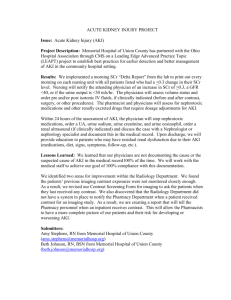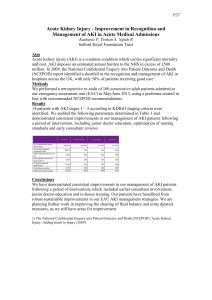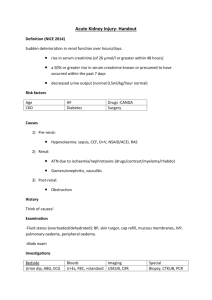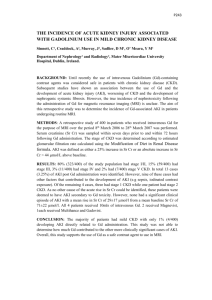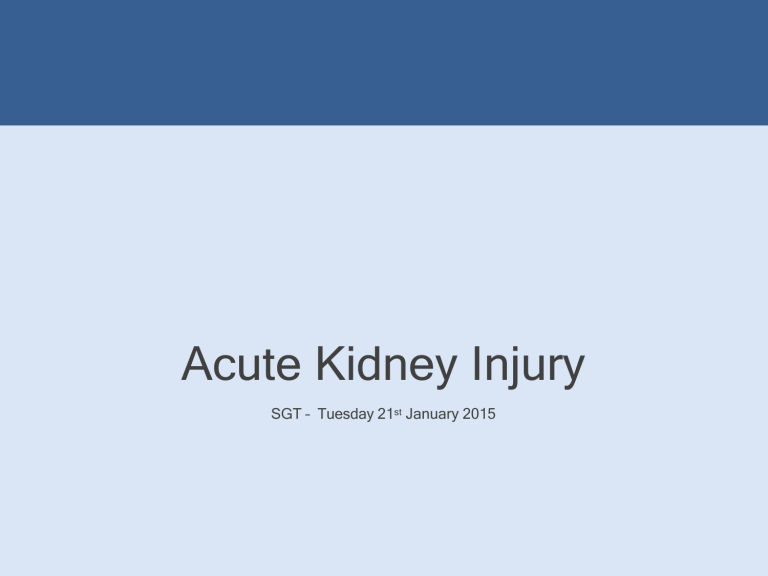
Acute Kidney Injury SGT – Tuesday 21st January 2015 NICE Guidance – CG169 • Approximately 13 – 18% of all people admitted to hospital have AKI, the mortality of which conditions depends on the severity, setting (i.e. ITU or not) and other patient factors but is estimated to be 25 – 30%. Stage of AKI • • Description Qualifying Factor 1 GFR > 90 2 60 < GFR < 89 Kidney damage; resence of structural issues, haematuria, proteinuria, microalbuminuria for > 3 months 3 30 < GFR < 59 4 15 < GFR < 29 5 GFR < 15 GFR < 60 for > 3 months, with or without kidney damage (as described above) Patients should be investigated for AKI under the following conditions; hypovolaemic, limited access to fluids, recent use of nephrotoxic drugs (NSAIDs, aminoglycosides, ACE inhibitors, AngII antagonists and diuretics), heart failure, liver disease, history of AKI, current CKD, sepsis, urological obstruction, diabetes and also aged over 65 if adult. For children, the same conditions apply but also; diarrhoea, symptoms of nephritis, hypotension or haematological malignancy. Investigation is done via measurement of serum creatinine. NICE Guidance – CG169 • • • • • As well as inpatients, there are other groups that should have AKI risk assessed; patients receiving surgery and those having iodinated contrast agents (for imaging purposes). Risk factors for patients receiving iodinated contrast agents; hypovolaemia, heart failure, diabetes and CKD combo, renal transplant, aged over 75, increased volume of agent and intra-arterial administration of agent. Risk factors for patients receiving surgery; intraperitoneal surgery, patients with sepsis, CKD, diabetes, aged over 65, liver disease, heart failure, use of nephrotoxic drugs after surgery (i.e NSAIDs). When patients are at risk, measures should be in place to monitor for oliguria (urine output < 0.5mL/Kg/hr. When patients have a raised serum creatinine, CKD and no obvious acute illness, the rise could be the result of an acute kidney injury as opposed to a worsening CKD. NICE Guidance – CG169 • • • • • AKI can be detected using RIFLE, KDIGO or AKIN definitions, in line with; serum creatinine increase of 26μmol/L in last 24 hours, 50% rise in serum creatinine over past 7 days, 25% decrease in GRF over past 7 days (for children and young people) or a fall in urine output to < 0.5mL/Kg/hr over 6 hours for adults and 8 hours for children and young people. Detection of AKI can be through urinalysis, where dipstick tests can indicate present of blood, proteins, nitrates, glucose and leucocytes; ultrasound should not routinely be offered. Pharmacological intervention in the form of loop diuretics may be offered when a patient is awaiting renal replacement therapy or recovering from it, to relieve fluid overload/oedema. Patients should be referred for renal replacement therapy when the following conditions are not responding to treatment; metabolic acidosis, hyperkalaemia, complications arising from uraemia (i.e. encephalopathy or pericarditis), fluid overload and pulmonary oedema. Observations of inpatients should be made at least every 12 hours, and will include; respiration rate, systolic blood pressure, oxygen saturation, level of consciousness and body temperature. KDIGO Criteria • • • The KDIGO criteria split AKI into three stages based on serum creatinine and urine output. Stage 1 AKI is typified by a serum creatinine of 1.5 – 1.9x the baseline, or a urine output of less than 0.5mL/Kg/hour for 6 – 12 hours. Stage 2 is characterised by a serum creatinine of 2.0 – 2.9x the baseline, or urine output of less than 0.5mL/Kg/hour for 12 – 24 hours and stage 3 is characterised by serum creatinine of 3.0x the baseline, anuria for 12 hours or more or a urine output of less than 0.3mL/Kg/hour for 24 hours or more or a decrease in eGFR to below 35mL/min in children and young people. Causes of AKI • • • • • AKI can have causes that are pre-renal, intrinsic to the kidneys, or post-renal. Pre-renal causes include heart failure, dehydration, sepsis and liver damage which can all affect the flow of blood to the kidneys, which in turn affects GFR and renal function. Anything causing hypovolaemia, hypoxia, massive systemic inflammatory responses and dramatic changes in RBF can potentially cause pre-renal AKI, which accounts for 65% of all cases. Intrinsic renal injury originates from the kidneys themselves, i.e. glomerular nephritis (haematuria and proteinuria) or nephrotic syndrome (proteinuria without haematuria). It can also be caused by drugs with nephrotoxic potential, like NSAIDs, aminoglycosides, Ang-II antagonists, ACE inhibitors and more. Post-renal causes of AKI are those which block the flow of urine along the ureters, or urethra. Origins include benign prostatic hyperplasia, tumours which impact on the aforementioned tubes and kidney stones. One of the commonest causes of AKI is sepsis, which can be detected in patients via the mnemonic SEPSIS; Slurred speech, Extreme muscle pain, Passing no urine, Severe breathlessness, I feel I might die, Skin mottled or discoloured. Monitoring AKI Risk • • • • • The best way to monitor AKI causes is via urine output. A reduced output (oliguria) can indicate AKI from any of the three aforementioned causes, i.e. dehydration (pre-renal), kidney damage (intrinsic) or kidney stones (post-renal). NEWS is a scoring system based on the observation of respiratory rate, systolic blood pressure, body temperature, level of consciousness, pulse and oxygen saturation. Temperature should be 36 – 38°C, systolic pressure should be 101 – 179mmHg, pulse should be 51 – 101 BPM, oxygen saturation should be above 96%, respiration rate is anywhere from 9 – 20 BPM and urine output should be greater than 0.5mL/Kg/hour. Children and young people at risk of AKI should also have their weight monitored twice daily for fluid retention, as well as creatinine, U’s and E’s. The first step in managing AKI is to identify and treat the underlying causes, and not the presenting symptoms in isolation. Then potential nephrotoxic drugs should be addressed, IV fluids administered if necessary, and the patient monitored with observations of urine output, serum creatinine, U’s and E’s.
